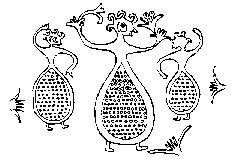
Home
Deep in Time - Poetry
About Cora
Holidays in Crete
Workshops in UK
Calendar of Events
Send Email to Cora
Ancient Crete |
 |
‘In Crete the great goddess was experienced
as a flowing, dynamic energy that could manifest in a swarm of bees, a
dolphin’s joyous leap, a flight of birds, the coiling of serpents and sea
creatures as well as in the human gesture.’
(The Myth of the Goddess, Baring et al)
The Minoan/Potnian civilisation of Crete which astounded the world when it began to be unearthed at Knossos in 1900, forced Europe to change its view of its own history, and continues to amaze us with its abundant evidence of the most vibrant, harmonious, artistic, peaceful and feminine culture Europe has ever known. It was clearly a shamanic culture, as shown by the ubiquitous images of animals in sacred situations, and humans merging into animal forms through rituals involving ecstatic dance. The sophisticated civilisation revealed,
‘the most complete acceptance of the grace of life the world has ever known. For life means movement and the beauty of movement was woven into the intricate web of living forms …, was revealed in human bodies acting their serious games, inspired by a transcendent presence, acting in freedom and restraint, unpurposeful as cyclic time itself’
Everywhere are symbols and images found in the Goddess cultures throughout thousands of years in Neolithic Europe, Egypt and the Near East. Above all labryses (double headed axes) labyrinths and meanders, snakes, butterflies and of course the bull are depicted as sacred tools and companions of priestesses. This is the culture which bridged the prehistoric, Goddess worshipping shamanism of old Europe and the Near East, and the modern age. In Crete lies the mythical cradle of the Greek Gods: Zeus was nursed there as a baby, hidden in a sacred cave from his divine father Cronus who would have devoured him. Here Artemis strode the mountains with her wild women companions, hunting and protecting the wilderness and female rites of passage. Here Ariadne danced in the labyrinth which later myth made the home of the monstrous minotaur, previously the sacred bull God. And here, the new sky Gods of Olympus waged war on the earth Goddess with her snake-dancing priestesses in countless tales of rape heralding the military regimes with oppressive religions which were to continuously invade and occupy Crete until our own century.